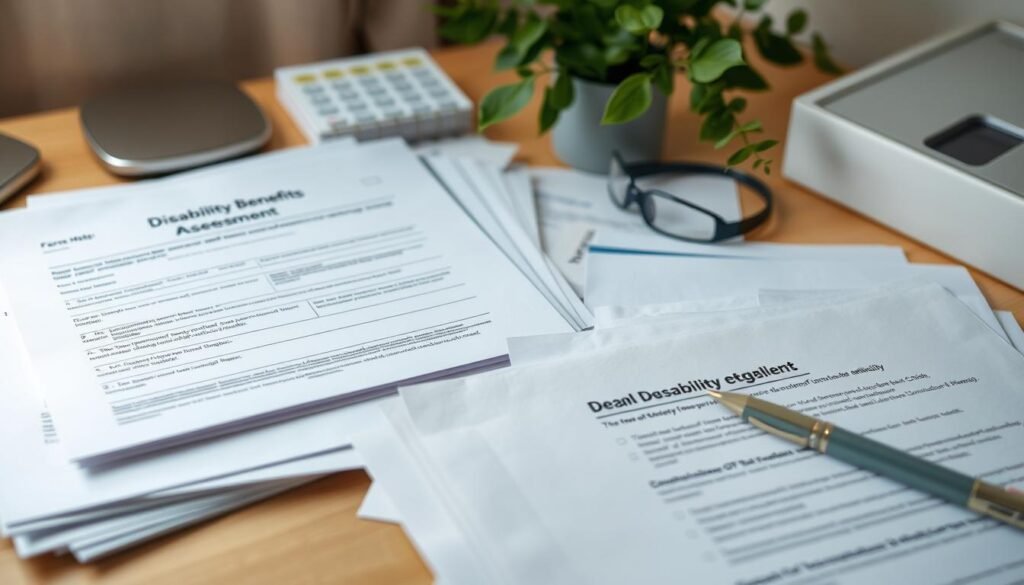Did you know over 301 million people globally suffer from anxiety disorders? Many might qualify for disability benefits. Anxiety is more than a state of mind; it can greatly disrupt daily life. In the U.S., most first-time Social Security Disability Insurance (SSDI) applications get denied. The reason? People don’t prove their anxiety significantly affects their ability to work. This piece shines a light on the link between anxiety and disability. We’ll discuss how anxiety disorders can lead to disability benefits. Plus, we explain what proof is necessary for a claim.
Key Takeaways
- Anxiety disorders can qualify for disability benefits if they are debilitating.
- Common types of anxiety disorders include generalized anxiety disorder, panic disorder, and social anxiety.
- Applicants must provide medical documentation of their condition and its impact on daily living.
- Eligibility for SSDI requires significant periods of work history and demonstrable impairment.
- Regular medical appointments are essential for maintaining evidence needed for a successful claim.
Understanding Anxiety Disorders
Millions in the U.S. struggle with anxiety disorders. These disorders cause challenges in everyday life and impact well-being. They come in different types, each with unique signs. It’s important for affected individuals and mental health workers to know about these disorders and their symptoms.
Common Types of Anxiety Disorders
There are several anxiety disorders that people can have. Knowing about them can help in getting the right help. The most common ones include:
- Generalized Anxiety Disorder (GAD)
- Panic Disorder
- Obsessive-Compulsive Disorder (OCD)
- Social Anxiety Disorder
- Agoraphobia
Symptoms of Anxiety Disorders
Symptoms of anxiety disorders can differ greatly. However, there are some common signs to look out for. These can really affect one’s life. Common symptoms are:
- Restlessness
- Easily fatigued
- Difficulty concentrating
- Irritability
- Muscle tension
- Sleep disturbances
Severe symptoms can hinder someone’s daily functions. If challenges are big, linking anxiety disorders and mental health disability benefits is key. Knowing how to document and understand symptoms is crucial for disability claims based on anxiety disorders.
Does Anxiety Qualify for Disability?
If you suffer from mental or psychological challenges, such as anxiety, you might be eligible for Social Security benefits. Many ask if anxiety can lead to disability benefits. The short answer is yes, but you must meet the SSA’s requirements.
Disorders related to anxiety fall under Section 12.06 in the SSA’s guidelines. This includes extreme fears, panic attacks, and PTSD. You need a formal diagnosis and must prove your condition severely impacts your life.
Can you get disability for anxiety? Yes, but it’s important to have medical records backing up your diagnosis. You must show you suffer from three out of five common anxiety symptoms. These symptoms could be feeling on edge, getting irritated easily, poor sleep, trouble focusing, and muscle stiffness.
To qualify, your anxiety must have been affecting you for 12 months or is likely to. Detailed medical records are key. They should cover your treatments, medications, and any counseling you’ve received. This helps show how anxiety has made daily tasks difficult for you.
Applicants also need to prove they struggle to handle routine changes. They should show problems with basic skills like understanding, interacting with others, or completing daily tasks. Detailed records are critical since many initial applications get turned down—about 70% of them, in fact.
Can You Get Disability for Anxiety?
People with anxiety disorders might look for disability benefits for financial help. To answer the question of getting disability for anxiety, we need to know available disability benefits and who can get them.
Types of Disability Benefits Available
The two main kinds of government help for those with anxiety are:
- Social Security Disability Insurance (SSDI): This is for those who have contributed to Social Security through taxes on their earnings.
- Supplemental Security Income (SSI): This helps people based on their financial need, without considering their work history.
Eligibility Criteria for Anxiety Disability Benefits
To be eligible for anxiety disability benefits, applicants must fulfill certain requirements. Important eligibility facts for getting disability with anxiety are:
- A medical record showing the anxiety has lasted for at least two years.
- Evidence of at least three out of six anxiety symptoms, such as being overly restless, getting tired easily, and trouble focusing.
- Showing significant trouble in one area of mental functioning, or noticeable trouble in two areas like social interactions or adjusting to changes.
- Continuous and consistent treatment is crucial, as gaps can cause claims to be denied.
In 2022, over 2.2 million workers got benefits for anxiety and similar conditions. Even with a high rate of initial rejections, more than half win their cases on appeal. Knowing the requirements well improves the odds of getting the support needed for anxiety.
Social Security Disability for Anxiety
Getting help through Social Security disability for anxiety starts with knowing your options. There are two main paths: Social Security Disability Insurance (SSDI) and Supplemental Security Income (SSI). SSDI is based on your work history and what you’ve paid into Social Security. SSI, on the other hand, is for those in financial need.
Overview of SSDI and SSI Programs
To get SSDI, you need enough work credits from your job. SSI is different because it looks at your income and assets. For people with anxiety, both programs offer important financial help if you can’t work because of your condition.
Documentation Needed for Eligibility
Proving you qualify for disability benefits for anxiety means having the right paperwork. You’ll need:
- Medical records that show your diagnosis and how you’ve been treated
- Assessments from psychologists or other experts
- Any records from hospital stays
- Stories from your family and friends about how anxiety changes your daily life
These documents must convince the Social Security Administration (SSA) you fit their criteria. They have specific guidelines under Listing 12.06 for anxiety disorders. This includes having clear evidence of symptoms, signs, and how your anxiety stops you from working or living normally.

Applying for Disability with Anxiety
Applying for disability due to anxiety can feel overwhelming. It’s crucial to understand the steps and gather the right evidence for success. This guide simplifies how to apply for Social Security Disability benefits for those in need.
Steps to Submit Your Application
To begin your application for disability due to anxiety, follow these steps:
- Determine Eligibility: Use the SSA’s online tool to see if you qualify for anxiety-related disability benefits.
- Gather Necessary Documents: Collect your medical history, treatment details, and notes on how anxiety affects your life.
- Complete the Application: Fill out the online form on the SSA site or visit a local office. Fill every part carefully to avoid delays.
- Be Prepared for a Possible Denial: Realize that most first-time claims don’t get approved. But you can always appeal the decision.
- Follow Up: Keep an eye on your application’s status. Decisions can take up to nine months.
Gathering Required Evidence
Collecting the right evidence is key to a strong disability application. You need to show both medical evidence and personal stories of how anxiety affects you. Steps to consider include:
- A doctor’s note detailing your anxiety diagnosis, treatments, and care plan.
- Details on how symptoms like restlessness or trouble focusing impact your daily life.
- Stories from your life that show how anxiety limits your everyday activities and coping skills.
By taking a detailed approach to gathering required evidence, your chance of getting benefits improves.
Qualifying for Disability with Anxiety
To get disability for anxiety, you need to know the rules from the Social Security Administration (SSA). You must prove you have an anxiety disorder that makes daily tasks hard. The SSA’s guidelines, in Section 12.06, say symptoms must majorly affect your life.
Panic disorder, agoraphobia, and obsessive-compulsive disorder (OCD) are some anxiety disorders that qualify. You need evidence that your anxiety stops you from living normally. For example, if you have panic attacks, you must show they make you constantly worry, affecting your social life and everyday jobs. OCD cases need to prove that repeated actions or thoughts are causing big problems.
When applying for these benefits, lots of medical proof is needed. This includes details on how long and how badly the anxiety has affected you, with records of treatment. Your chances are better if your symptoms have lasted or will last over 12 months. Showing that you’re getting help, like therapy, can really help your claim.

You also need to explain how anxiety limits what you can do. This might be trouble focusing, always feeling tired, or getting easily upset. Showing how the disorder changes your daily activities is key to getting disability benefits for anxiety.
Mental Health Disability Requirements
Understanding the requirements for a mental health disability due to anxiety can be tough. It’s important to know what the Social Security Administration (SSA) needs for a claim. Strong documentation of your condition is the first step to a successful application. By offering detailed proof, you can meet the SSA’s criteria. This shows how anxiety affects your daily life significantly.
Documenting Your Condition
It’s vital to document your anxiety disorder well to get benefits. Think about including these when you document:
- Medical records from mental health professionals
- Treatment history, highlighting ongoing therapy or medication
- Reports from psychological evaluations
- Daily activities and how anxiety affects them
- Any hospitalizations or emergency treatments
This detailed evidence helps your claim. It also meets the SSA’s criteria. These include evaluating limitations in understanding, interacting, focusing, and adapting.
Understanding the SSA’s Assessment Criteria
The SSA has specific criteria for mental disorders, like anxiety. For example, listing 12.06 covers anxiety and obsessive-compulsive disorders. The focus is on the severity. To meet these requirements:
- You need a documented history of your disorder for at least 2 years. This shows it’s “serious and persistent.”
- You must show extreme limitation in one area or marked limitation in two areas. These areas include mental functioning domains.
- Showing symptoms like irritability, sleep issues, or muscle tension strengthens your application.
Applicants must prove how their anxiety disorder impacts daily living. Meeting the disability requirements involves more than just stating you have anxiety. It means showing its effects through consistent and detailed documentation.
| Criteria | Description |
|---|---|
| Severity of Condition | Extreme limitation in one area or marked limitation in two areas of mental functioning |
| Documented History | A record showing at least 2 years of the disorder’s existence |
| Symptoms | Must demonstrate at least three of the following: restlessness, difficulty concentrating, irritability, muscle tension, sleep disturbance, easy fatigue |
Challenges in Getting Approved for Disability
Getting disability benefits for anxiety is tough. Many people find it hard to get approved. This is because anxiety disorders are not easy to prove. Also, the Social Security Administration (SSA) needs a lot of medical proof.
Many people get denied the first time. But knowing why people often get denied can help. It can make your case stronger.
Common Reasons for Denial
There are several reasons why applications get denied:
- Inadequate medical documentation: Not enough medical proof can lead to a rejection.
- Perceived skepticism: Mental health claims are often not taken as seriously as physical health issues.
- Failure to demonstrate severity: It’s important to show that your anxiety really affects your life.
- Lack of consistent treatment: You must get regular medical care or you might get denied.
- Incompleteness of forms: Make sure professionals fill out all the right forms completely.
How to Increase Your Chances of Approval
To better your odds of getting disability benefits, consider these tips:
- Gather comprehensive medical evidence: Detailed records of your symptoms help your case.
- Document daily struggles: Write down how anxiety impacts your everyday activities.
- Seek legal assistance: Disability claim experts can guide you through the process.
- Be persistent: Many succeed in appeals; don’t give up after an initial denial.
- Utilize hospitalization records: Records from hospital visits prove how serious your condition is.
These steps can greatly increase your chance of getting disability benefits.

| Reason for Denial | Impact on Approval |
|---|---|
| Inadequate medical documentation | High |
| Perceived skepticism of mental health claims | Moderate |
| Lack of consistent treatment | High |
| Insufficient demonstration of severity | High |
| Incomplete forms or assessments | Moderate |
Resources for Individuals with Anxiety
Finding the right resources is key in effectively managing anxiety. There are many support organizations and professional services ready to help.
Support Organizations and Advocacy Groups
There are support organizations that help people struggling with anxiety. These groups provide valuable information, a sense of community, and direction:
- National Alliance on Mental Illness (NAMI) – NAMI offers free resources, support groups, and education for those dealing with mental health issues.
- Anxiety and Depression Association of America (ADAA) – ADAA gives details on anxiety disorders, treatments, and resources designed for individuals.
- SAMHSA (Substance Abuse and Mental Health Services Administration) – SAMHSA has a national helpline and a service to help find mental health professionals.
Professional Help and Counseling Services
It’s important to seek professional help for managing anxiety well. People might consider:
- Therapy – You can find both face-to-face and online therapy options, usually offering both counseling and medication.
- Primary Care Providers – They can screen for mental health issues and refer you to specialized counselors when needed.
- Employee Assistance Programs (EAP) – Many employers offer EAPs, giving free and confidential counseling to their workers.
The Centers for Medicare & Medicaid Services and the U.S. Department of Veterans Affairs have tools to help find providers in their networks.
Conclusion
It’s key to understand how to secure disability benefits for anxiety. This matters a lot for those deeply affected by anxiety disorders. About 19.1% of U.S. adults face these issues each year. They often ask, can you get disability for anxiety? The Social Security Administration states specific rules. One needs to meet these, especially under code 12.06, to get help.
The process to apply isn’t easy. It often gets complicated by missing documents or misunderstanding mental health. This leads to about 25% of people getting wrongly denied, leaving families in tough spots. That’s why having complete records and strong proof is vital to show you need disability benefits for anxiety.
If you’re facing anxiety disorders, know there are ways to get help. Working with mental health experts and keeping detailed records of your symptoms can help your case. This makes it easier to meet the requirements for support. With good guidance, you can work through the process and get the aid you deserve.